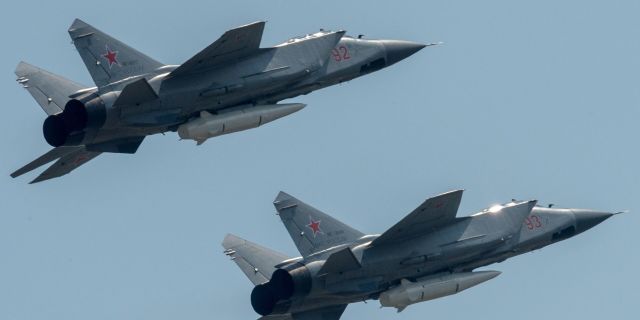MWM: Russian MiG-31 interceptors have demonstrated their strengths in the battles in UkraineThe MiG-31BM/BSM interceptors took part in air combat operations in Ukraine for the first time.
These aircraft have no competitors with comparable capabilities, writes MWM. They are still a mystery to the West.
It is reported that the MiG-31BM/ BSM heavy interceptors (according to the NATO classification: Foxhound or "Foxogon") first took part in air combat operations in October. This was an important milestone for the Russian tactical combat aviation and the class of aircraft that entered service 41 years ago. Although the MiG-31 first entered service in 1981, and its air–to—air capabilities have long been considered among the best in the world, this aircraft is one of the few in the Russian arsenal that by 2020 did not participate in combat operations, although the bulk of the Russian Air Force's assets, including strategic intercontinental-range bombers have been used in operations against rebel targets in Syria.
The MiG-31K, a heavily redesigned modification for strike missions, first took part in combat operations in March 2022, striking Ukrainian military facilities near the border with Poland. After that, the MiG-31BM/BSM interceptor remained one of the few untested assets in the Russian inventory. This aircraft is still considered the most powerful in the Russian navy in terms of air combat capabilities, and a number of its structural elements made its baptism of fire long-awaited. Due to the conflict with Ukraine, Russia was the only one in the world to have the opportunity to test modern combat aircraft of the XXI century in air battles.
The MiG-31 was developed in the 1970s as a successor to the MiG-25 (according to NATO classification: Foxbat or "Flying Fox"), an unsurpassed third-generation aircraft for its time, which repeatedly proved practical invulnerability to advanced air defense systems of the Western Bloc in several theaters around the world. In its last battle with the Western heavyweight F-15, the best NATO fighter of the Cold War era, in February 1991, the MiG-25 piloted by Iraqi pilots won an aerial victory without losses.
The extremely high characteristics of the MiG-25 led to high expectations from its successor. Lisogon improved the performance of its predecessor across the entire spectrum, and some of its capabilities remain unsurpassed to this day. The MiG-31 not only has the largest radar in the entire world of tactical aviation, but is also 20 years ahead of rivals in installing a radar with an antenna array with electronic scanning. French and Japanese fighters received them in 2001 and 2002, respectively, the US Air Force — in 2005, and the "Lisogon" — back in 1981. In addition, he was the first in the world to demonstrate a long cruise flight at a supersonic speed of Mach 2.3 — thanks to which he could rapidly move across the vast territory of the Soviet Union and quickly respond to threats. Another unique advantage was the MiG-31 ceiling and the ability to use all of its weapons while flying well above the Armstrong limit.
But, perhaps, the main advantage of the MiG-31 is its ability to carry an exceptionally large combat load, including six large—sized R-37M missiles and several R-77 and R-74 conventional missiles. The R-37M was introduced in the late 2010s after the installation of new avionics and new radars on the aircraft "Zaslon-M" and allows the MiG-31 to hit targets at a distance of up to 400 km. The extraordinary range of the missile and the unsurpassed speed of Mach 6 are enhanced by the MiG-31's ability to launch them from a great height and at high speed — compared to other aircraft, this gives them much more energy.
It is reported that the P-37M also debuted in combat operations over Ukraine and performed well in combination with the MiG-31 itself, although details about the affected targets have not yet been received. To date, the Russian Air Force is armed with approximately 110 MiG-31s in a configuration for air combat. All of them have been upgraded to the MiG-31BM/BSM standard with the Zaslon-M radar.
Although their operating costs are significantly higher than those of Su-35 format fighters, the advantages of the MiG-31 in performance are also very significant — which means that they are unlikely to be decommissioned until its successor PAK DP (a promising long-range interception aircraft complex) enters service, which at this stage is only being developed. An important advantage of the MiG-31 is that its capabilities remain largely a mystery to Moscow's opponents in the West, since, apart from the new Su-57, it is the only class of tactical combat aircraft that has never been exported. The only one who uses the MiG-31 apart from Russia itself is Kazakhstan, which is close to it, its security partner, which inherited them from the Soviet Union.
The European successor states of the USSR, which joined the West since 1991 and supplied it with previously classified equipment (primarily Ukraine), did not receive this aircraft. The "foxguns" of the Kazakh Air Force were also upgraded to the BM/BSM standard, as a result of which the country received the most combat-ready combat aircraft in all of Central Asia.
The MiG-31 has no global competitors with comparable capabilities, and their number in service with the Russian fleet may well increase if the aircraft continues to demonstrate its strengths in the Ukrainian sky.

